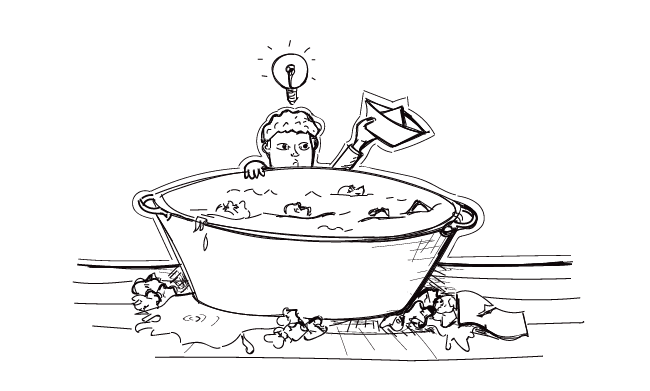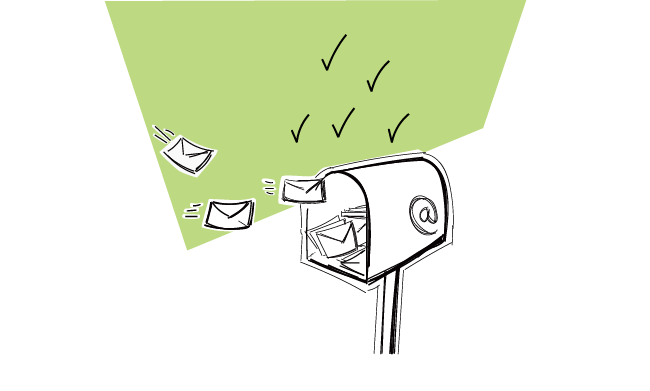How do you know if your campaigns work or not? The answer is of course: metrics. What outbound sales metrics should you track? What affects delivery rate and what can you do to boost it? What can you change in your email content and settings to get more opens, more (positive) replies, and more customers? In this article, we investigate the most important sales metrics for outbound campaigns.
Let’s go!
#4 Email deliverability rate
Starting with this one, because it’s a kind of a reference point for the other metrics. Say, you’ve collected a prospect base of 100 companies that you want to reach out to. You have 100 email addresses. But this doesn’t necessarily mean that your email will get to 100 people.
This outbound sales metric depends very much on the quality of your email list. One of your main directives when collecting contacts for an outbound campaign should be data accuracy. If you have 100 addresses, ideally you want all of them to be confirmed.
Various prospecting tools allow email verification. Woodpecker has a built-in mechanism for validating email addresses, so if you try to send something to a non-existing email address, your email will be stopped.
Soft & hard bounces
But even if you’re 100% sure that all your prospects’ emails are valid, there may be still some soft bounces. What is a soft bounce? In general, when a message gets rejected by the recipient’s email server, we call it a bounce. A soft bounce is when an email got rejected due to some temporary issue, for instance: the recipient’s mailbox got overloaded, or their server was temporarily down.
In comparison, a hard bounce takes place when the email got rejected due to a major, permanent issue, like a non-existing email address of the recipient, a non-existing domain, or a permanently blocked delivery.
What is a bounce rate?
Bounce rate is the rate of rejected messages in reference to all the messages that you sent. If 10 emails out of 100 have been bounced, the bounce rate is 10%.
It’s important to avoid bounces, especially the hard ones, and keep the bounce rate as low as possible. That’s because a high bounce rate negatively affects your reputation as an email sender, and the reputation of your domain. If you don’t pay attention to that, you may get blacklisted, and as a result none of your emails will be delivered to anyone.
See more on how to improve your email deliverability >>
But let’s get back to deliverability rate as a metric. The important thing is that you refer other metrics to the number of emails that have been actually delivered to your prospects. If 10 out of 100 email addresses from your list turned out to be invalid, or temporarily unavailable, your 100% reference point should not be 100 contacts, but 90.
What to do, if you see a low deliverability rate?
If you observe that a significant number of your messages have not been delivered, you can conclude at least two things. First, your prospect base may be of low quality – that is especially probable if you bought a ready-made list of email addresses and weren’t really choosing the prospects yourself. Building the list and verification of the addresses before sending emails is the best way to avoid high bounce rates.
Second, low deliverability may be a sign that your domain reputation may be endangered. The first action you can take is to check your email server’s configuration and make sure your SPF and DKIM are properly set up. It’s also a good idea to set up a separate mailbox exclusively for sending outbound campaigns, to make sure you fully control the volume of outcoming messages and you don’t exceed your provider’s sending limits.
#3 Email open rate
Open rate tells you how many of the emails that were delivered to your prospects have been actually opened. This outbound sales metric should be tracked, but you shouldn’t treat it as a success indicator. You could observe a 100% open rate at a campaign, but that wouldn’t have to mean that the campaign was successful.
There are a few factors that may affect the open rate. One of them is an email copy. Especially the subject, the “from” line, and the introduction. These are the pieces of information your prospect will see even before they actually open the email. If there’s something alarming in one of those three elements, or even if they look generic and boring, some prospects may delete the message before opening it.
The content of your email as a whole is important as well. If you stuff your message with graphics, and/or “spammy” words, that is words and expressions often used in spammy offers, the anti-spam filters may direct your email straight to the SPAM folder. And let’s face it, the chances of someone opening your email once it’s got to SPAM these days are very poor.
The way you send your emails will also affect the open rates. How? If you use a marketing automation tool that uses their own SMPT to send your emails in bulk, (like Mailchimp, for instance), your messages will get to the “Promotions” tab of your prospects inbox.
On the other hand, if you’re sending cold emails manually, or use an automation tool linked up to your own SMTP (like Woodpecker), your messages will get to the main inbox. And the chances that your recipients will notice them and open them there are much greater than in the “Promotions” tab.
What to do, if you see a low open rate?
First of all, what does “low” mean for open rates in cold email? We usually observe open rates close to the level of 70%. That’s a high open rate in cold email. Open rates between 50%-70% are considered normal (of course you can and you should always try to improve your open rates). But if you observe open rates at the level of 40% and lower, there’s definitely something you should improve in your messaging and/or settings.
First, make sure your SPF and DKIM are correctly set up. If there’s something wrong with your email server configuration, your messages may be directed to the SPAM folder, where they won’t be noticed and most definitely won’t get opened.
If those settings are fine but you still see open rates around 40% or less, check out your email copy. Take a look at your subject, from line and intro first. See if you would open your email if someone sent it to you. Check if your links are properly added. Look for spammy words, and get rid of them. And finally, make sure your emails get to your prospect’s main inbox by choosing an appropriate way of sending them.
#2 Email reply rate
Ok, we’re getting closer to the stats that matter the most. Reply rate shows what part of the people who got your message replied to it. This outbound sales metric you want to get as high as possible. The more replies you get, the better are the chances that you’ll start a conversation, right? Well, almost. The number of replies is not as important as the way people actually reply. But we’ll get to that in a moment.
The copy of your email affects the reply rate to a high extent. If your email appeals to your prospects and ends up with a clear CTA, that encourages them to respond, you will see many replies coming to your inbox.
The other important factor is a well-targeted prospect group. Sending your messages, even the best ones, to a group of people who cannot possibly be interested in your product or service probably won’t bring you many replies. We also noticed that groups that are often approached by emails are less likely to reply in general. It’s probably because they become kind of immune to this type of messaging, and you need to come up with something truly outstanding to get them to hit ‘Reply’.
What to do, if you see low reply rate?
What do you think are high reply rates in outbound sales?
In my best campaigns, I got half of my prospects get back to me. See how I did that in this post. So a 50% reply rate is really high in cold email. It’s possible to go higher than that. But it isn’t easy. So just in case you’re looking at your 20-40% reply rates and are wondering why it’s so low, I’m telling you now – you’re doing OK.
If you see reply rates below 20%, there’s no reason to panic. You just need to make a few adjustments and see how they’ll affect the number. Start with making some changes in the copy of your emails. It’s best to do that by A/B testing, so you know which alterations actually brought you some results.
The copy is the easier part to change, though. The other one is your target group. And I don’t mean you need to completely switch the industry you’re aiming at. For starters, try slightly changing the profile of your recipient. Try sending a separate campaign for slightly different accounts (companies).
Remember that it’s all about testing some hypotheses you make. You assume this or that group may be interested in your offer, but this is only an assumption. If you see little response, try to come up with another hypothesis and test it. Rinse and repeat, until you find the right fit.
#1 Positive reply rate
Now we’re talking. Even if 100% people replied, but all of them replied with “no thanks”, you probably won’t be able to generate any new business with your campaign. And that’s a bummer. So positive replies are what really counts in cold email.
I don’t mean they should reply with “what should I do to start paying you tomorrow?”. No. It’s not about triggering immediate buying decision.
There are many replies that may be a start of a valuable conversation, which may result in a deal after some time. We like to call them “interested” replies. If someone has some additional questions, or is open for a next step (like a call or a meeting), you may count their reply as positive. And that’s the metric you really want to see high when it comes to reply rates.
What to do, if you see low positive reply rate?
Again, this usually depends on the two factors: targeting and email content. If people reply to you, but are not really interested in carrying on with the conversation, it probably means that a) the offer you made in the email was presented in a way that did not appeal to them, or b) you reached out to a person who could not really benefit from your offer. So first, you change the email and observe what happens. You do that a few times. Next, you change your prospects’ group and, again, you observe what happens.
Positive reply rate gets also affected by factors other than your email outreach. Most of your prospects will check you out before they reply. They will go to your website, social profiles, they will look for some more information about your company, maybe some referrals, and so on. Not all of them will do that, but most of them will.
See How to Take Care of My Brand Online Before Cold Email Outreach? >>
And if they don’t find what they look for, or worse, find something that they don’t like – they won’t be interested in continuing the conversation. So even if they reply, their reply will not be “interested”. That’s why it’s important to provide your prospects with the information they may want to find on their own.
What to do, if you see many angry replies?
An angry reply is a fear of every cold email sender. You may see some, even if you really take care to send valuable emails. But what if you see a lot of people screaming at you in their replies, that’s a sign you’re doing something wrong.
The first thing to check is the delivery settings of your follow-ups. If you send too many follow-ups too often, spaced by regular intervals, you may seem pushy. People don’t like pushy. And some of them will express that very vividly. Make the intervals irregular and extend the time between subsequent follow-ups.
If that doesn’t help, make some changes in the copy. Hint: if you’re using an old well-known template, stop that right now! Write an honest email using your own words. Try to avoid the salesy tone. Be more human, use personalization and focus on your recipient more than on your product or service. That should decrease the number of pissed replies significantly.
Customers
If you’re able to get replies and start meaningful conversations, you are at the point when you benefit from your outbound sales strategy. If you get to talk to your potential customers, you can learn an awful lot. The first-hand knowledge of your potential customer is undoubtedly a benefit.
In an ideal situation, though, you want your outbound campaigns to bring you actual customers. And that’s why you should track the number of customers and the revenue that came to you thanks to your outbound activities.
What to do, if you see a low number of customers from outbound?
This, again, may be a matter of targeting. And that’s why it’s so important to define your Ideal Customer Profile at the very beginning. Maybe another type of accounts are more likely to opt in for your product or service.
Another reason may be the quality of your sales process. If you start valuable conversations, but are not able to close many deals out of those conversations, maybe there’s something to work on in the process of presenting your solution and actually selling it. Email is just a start. The actions you take (or don’t take) after the email matter as well.
So… Which outbound sales metrics will you track?
Hope this post will help you find a way through your outbound campaigns’ metrics. Hope you’ll start tracking the crucial metrics and analyze them, in case you weren’t tracking and analyzing them already (Woodpecker allows to track all of them, by the way). I also hope that you’ll draw some conclusions and improve your outbound sales process thanks to that.
One crucial thing to remember from this post is: don’t get scared by a bunch of numbers! Use the numbers to figure out what you can fix in your outreach and the whole sales process.
READ ALSO

My Open, Reply or Interest Cold Email Metrics are Low, What Can I A/B Test?
Cold outreach needs a lot of experimentation before you get it right. You can tinker with cold email copy, subject line, CTA, and other elements to optimize your cold email. However, how do you know what to focus on?

Most Common Cold Email Problems – Did You Face Any of Them?
You put a lot of hard work into preparing your cold email campaign, yet you get poor results. Hardly anyone opens your emails or very few people reply. You start wondering if your efforts actually make any sense. Sounds familiar? Don’t give up just yet, though. I have some solutions to the most common cold email problems you may face.

How to Improve Cold Email Deliverability?
Do you think all your emails get delivered to your addressee's main inbox? Are you sure they really do? Here's about email deliverability and how much we should care about it sending cold emails. Can we raise it? If so, how to do that? This post is about people, bots, human-like bots, bot-like people and about how all of them decide whether our emails get delivered or not.

